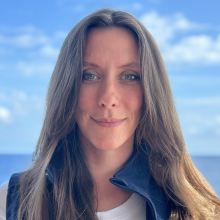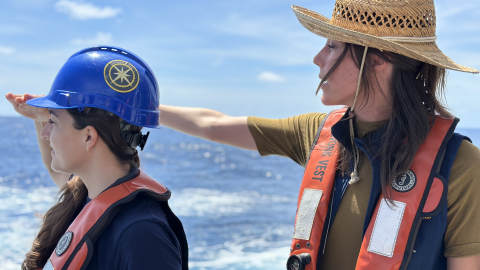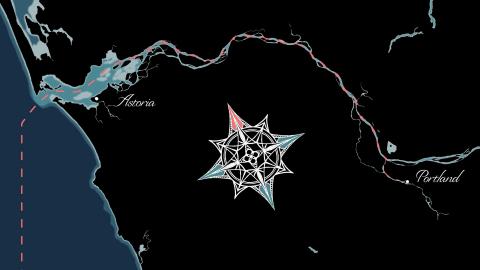
Hayley Drennon
Tell us about your work/research. What kinds of things do you do?
I work at Lamont-Doherty Earth Observatory as a Research Assistant to Senior Research Scientist Dr.Vicki Ferrini. Under her leadership, our team is involved in various projects such as Global Multi-Resolution Topography (GMRT), Seabed 2030, Marine Geoscience Data System (MGDS) and other seafloor mapping and data initiatives. We gather, process, and coordinate data ensuring that high-quality marine geoscience research data are made available to science and the public. My research is conducted synergistically with these projects, utilizing the seafloor data to characterize and analyze benthic habitats, with the goal of using these characterizations to inform future mapping endeavors.
What sparked your initial interest in your career?
Being born in a coastal town, my early years were steeped in marshland, tide pools, and sand dunes. The rich ecology of the Lowcountry spurred my desire to explore the natural world- drawn to understanding my environment. My other passion is for a good story, and I have found, throughout the years, that science is nothing if not a compelling, constantly evolving, story.
Who influenced you or encouraged you the most?
I have been blessed to have many passionate teachers but I credit my first advisor and mentor with helping to guide me to where I am today. “Doc” Leslie Sautter initiated me into seafloor research through the College of Charlestons Benthic Acoustic Mapping and Surveying (BEAMS) program. Doc not only introduced us to the world of seafloor mapping and how to use the data within our research but she also encouraged her students to hold themselves to a higher standard and pushed us to look deeper into the data to discover the full story of the seafloor.
Above all, my mother has been a constant source of inspiration in my life. She has instilled in me a sense of tenacity, nurtured my curiosity about the natural world, and unwaveringly supported my goals, even when my chosen path became challenging or a tad meandering– she always remained my steadfast support.
What element of your work/study do you think is the most fascinating?
The most compelling element for myself currently, is being able to visualize for the first time, areas I have helped process/habitats I have characterized, via ROV/AUV and making first-order observations of the deep-sea coral ecosystems and the benthic organisms.
What other jobs led you to your current career?
My participation in the College of Charleston's Benthic Acoustic Mapping and Surveying (BEAMS) program led me to summer work at Lamont. This work allowed for several seafloor mapping research and science communication and outreach with both the College of Charleston and Dr. Ferrini's group. In addition to this, I was able to conduct research presenting studies on structural geomorphology, multi-spectral imaging, habitat characterization, and large deep-sea bedform characterization.
What are your degrees and certifications?
BSci in Marine Biology, Geology (2020), BEnthic Acoustic Mapping and Surveying Program (BEAMS), Multibeam Course (2023)
What are your hobbies?
I enjoy reading, hiking, and exploring. Whether it be through a good book, studying cultures from around the world, or wandering through a city— I love experiencing a story well told.
How did you get involved with the Ocean Exploration Trust?
By attending and presenting at scientific conferences I connected with other passionate individuals in my field. Through discussions with those who would inevitably become my future colleagues and friends I discovered OET aspires to not only explore, but share the underwater world with the world– I realized I desired to both contribute to their mission as well as grow my skills in mapping and marine science technologies through participation in future expeditions.
What advice would you give someone who wants to have a career like yours?
My advice would be to start by seeking schools with robust geoscience and ecology programs, but don’t stop there. Building relationships with your professors is key—they often have insights into certifications, internships, and programs that align with your passions. Diversify your experiences, skillsets, and interests. Don’t feel pressured to settle on one path too soon—explore opportunities that challenge you and push you out of your comfort zone. The seafloor mapping community is incredibly diverse, with members coming from backgrounds like art, music, education, and biology. You never know where your journey might lead. Be proactive—reach out to people in the field, send emails, make connections, and find mentors who inspire you. My mentor and advisor was not actually the one the university designated me, I found her, and was inspired by her dedication. Ultimately, find your unique niche and carve your path.
I love experiencing a story well told.
Expeditions
Hayley participated in the following Ocean Exploration Trust expeditions:


